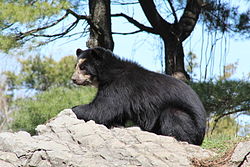| Queens Zoo | |
|---|---|
 Andean bear female at the zoo | |
 | |
| 40°44′42″N 73°50′54″W / 40.74500°N 73.84833°W | |
| Date opened | February 28, 1968 (children's farm) October 26, 1968 (rest of zoo) |
| Location | Queens, New York, United States |
| Land area | 11 acres (4.5 ha) |
| No. of species | 112 (as of 2013)[1] |
| Memberships | AZA[2] |
| Management | Wildlife Conservation Society |
| Public transit access | Subway: Bus: Q23, Q48[3] LIRR: Port Washington Branch at Mets–Willets Point[3] |
| Website | www |
The Queens Zoo (formerly the Flushing Meadows Zoo and Queens Wildlife Center) is an 11-acre (4.5 ha) zoo at Flushing Meadows–Corona Park in Queens, New York City, between Grand Central Parkway and 111th Street. The zoo is managed by the Wildlife Conservation Society and is accredited by the Association of Zoos and Aquariums (AZA). Built along with the Queens Zoo is a children's zoo, which was originally called the Heckscher Children's Farm.
New York City parks commissioner Robert Moses had wanted to add a zoo to Flushing Meadows–Corona Park after the 1964 New York World's Fair. Plans for the zoo were first announced in 1964 as part of the Queens Botanical Garden, but construction for the zoo did not begin until August 20, 1966. The Heckscher Children's Farm, the first part of the new zoo, opened on February 28, 1968, and the rest of the Flushing Meadows Zoo opened on October 26, 1968. The New York City Department of Parks and Recreation contracted Wildlife Conservation Society to operate the zoo in 1988. The zoo was closed for renovations for four years, reopening in 1992; it added numerous animals and exhibits after it reopened. The Queens Zoo was nearly shuttered in 2003 due to budget cuts.
The zoo is home to more than 75 species that are native to the Americas. Unlike contemporary zoos, the Queens Zoo did not put animals in cages except when necessary; since the zoo's habitats are open-air, it focuses mostly on animals native to the Americas. The main zoo (now the zoo's wild side), on the eastern portion of the site, contains landscape features such as a marsh and artificially warmed rocks. The domestic side of the zoo, originally the Heckscher Children's Farm, includes domesticated animals. The zoo's aviary is a geodesic dome designed by Thomas C. Howard of Synergetics, Inc. and used during the 1964 fair.
- ^ Cite error: The named reference
Kadet 2013was invoked but never defined (see the help page). - ^ "Currently Accredited Zoos and Aquariums". aza.org. AZA. Retrieved May 27, 2010.
- ^ a b c "Queens Bus Map" (PDF). Metropolitan Transportation Authority. August 2022. Retrieved September 29, 2022.